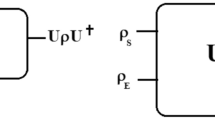Abstract
This paper presents a new method for fault-tolerant computing where for a given error rate, r, the hamming distance between correct inputs and faulty inputs, as well as the hamming distance between correct results and faulty results, is preserved throughout processing; thereby enabling correction of up to r transient faults per computation cycle. The new method is compared and contrasted with current protection methods and its cost/performance is analyzed.



Similar content being viewed by others
References
Bell D, Laxton R (1975) Some BCH codes are optimal. Electronics letters 11:14
Blahut RE (1983) Theory and practice of error control codes, Addison-Wesley
Cassel M, De Lima FG (2006) “Evaluating One-Hot Encoding Finite State Machines for SEU Reliability in SRAM-based FPGAs,” in Proc. of 12th IEEE International On-Line Testing Symposium, pp 139–144
Chen W, Gong R, Liu F, Dai K, Wang Z (2006) “Improving the fault-tolerance of a computer system with space-time triple modular redundancy,” in Proc. of International Conference of Embedded Systems Applications, pp 183-190
Dolev S and Frenkel S (2008) “Toward Hamming Processor,” Technical Report, #08-05, Dept. of Computer Science, Ben-Gurion University of the Negev
Hass KJ, Gambles JW, Walker B, Zampaglione M (1998) “Mitigating single event upsets from combinational logic,” in Proc. of 7th NASA, Symposium on VLSI Design, vol. 4.1, pp. 1–10
Hentschke R, Marques F, Lima F, Carro L, Susin A, Reis R (2002) “Analyzing area and performance penalty of protecting different digital modules with hamming code and triple modular redundancy,” in Proc. of the 13h Symposium on Integrated Circuits and Systems Design, p. 95–100
Jasinski R, Pedroni VA (2004) “Evaluating logic resources utilization in an FPGA-based TMR CPU,” in Proc. of the International Military and Aerospace Applications of Programmable Logic Devices, pp. 1005
Lala K (2001) Self-checking and fault-tolerant digital design, Morgan Kaufmann
Lima F, Cota E, Carro1 L, Lubaszewski M, Reis R, Velazco R, Rezgui S (2000) “Designing a radiation hardened 8051-like micro-controller,” in Proc. of 13th Symposium on Integrated Circuits and Systems Design, pp. 255–260
Mavis DG, Eaton PH (2002) “Soft-error rate mitigation techniques for modern microcircuits,” in Proc. of 40th Annual Reliability Physics Symposium, pp. 216–225
Nelson VP (1990) Fault-tolerant computing: fundamental concepts. IEEE Comput 23(7):19–25
Nicolaidis M (2003) Carry checking/parity prediction adders and ALUs. IEEE Trans Very Large Scale Integr Syst 11(1):121–128
Reyhani-Masoleh A, Hasan MA (2004) Low complexity bit parallel architectures for polynomial basis multiplication over GF(2m). IEEE Trans Comput 53(8):945–959
Spielman D (1996) “Highly Fault-Tolerant Parallel Computation,” in Proc. of the 37th IEEE Annual Symposium on Foundations of Computer Science, pp. 154–163
Xin L, Shen K, Huang MC, and Chu L (2007 “A Memory soft-error measurement on production systems,” in Proc. of USENIX Annual Technical Conference, pp. 275–280
Author information
Authors and Affiliations
Corresponding author
Additional information
Responsible Editor: K. Saluja
Rights and permissions
About this article
Cite this article
Dolev, S., Frenkel, S., Tamir, D.E. et al. Preserving Hamming Distance in Arithmetic and Logical Operations. J Electron Test 29, 903–907 (2013). https://doi.org/10.1007/s10836-013-5421-9
Received:
Accepted:
Published:
Issue Date:
DOI: https://doi.org/10.1007/s10836-013-5421-9




